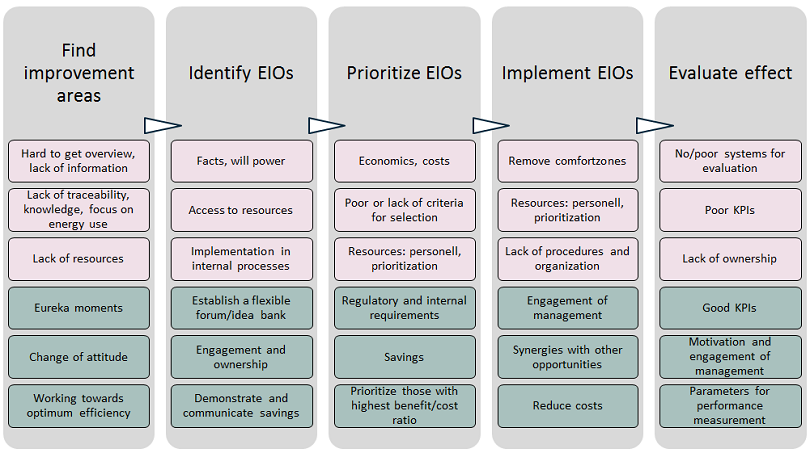Improvements over the current situation are achieved by actions. Improvement opportunities will be gradually identified through the management system, but a routine is also needed to capture ideas, assess and prioritize them, and then implement. Over time, evaluating the effect of implemented actions is equally important.
Many companies have already established their own list of Energy Improvement Opportunities (EIOs), to keep an overview over the reviewed and implemented actions. This is useful in order to transfer the knowledge and experience from one installation to another. Further, this also works well for raising awareness and communicating improvements. Finally, this is also becoming a requirement from the authorities to report identified and implemented EIOs.
If you are looking for example of Energy Improvement Opportunities, have a look at the list.
The improvement opportunities process
The measures process is used to plan and execute actions that will improve energy efficiency. A group assignment from the project helped identifying barriers (red) and possibilities (green) sorted for the different steps through the measures process. The most important are illustrated in the diagram below.

Another group assignment from the project collected good ideas for the measures process. Cultural change is central, and as energy manager/part of the energy team you must dare to challenge established truths (“this is how we always have done it”). A fact based decision foundation that considers both probabilities and consequences for upside and downside helps in these discussions.
| How to identify the improvement potential |
|---|
|
| Prioritize Energy Improvement Opportunities |
|---|
|
![]() How to set up EIO lists
How to set up EIO lists
Bruken av tiltakslister vil variere fra selskap til selskap. Noen har den kun for informasjonsoppbevaring, mens andre bruker den aktivt inn for å overvåke fremgang med tanke på for eksempel reduksjon av CO2 utslipp.
Examples of purposes include:
- Pick list for good ideas
- Overview and reference of opportunities and experience
- Input to ask good questions for new constructions or projects
Regardless of the purpose, there is also some practical advice:
- Have an owner for the list (e.g. energy manager), but remember that input must come from operations/technical teams
- The effect after implementation of a measure should be followed up over time
- Let the list be a living document that matures with experience
- Keep the list short and concrete
Most people use an Excel-based list. Although many details can be included for the EIOs, begin with the most important ones. A list of categories is given below, and you can find an example of a standard Excel setup here.
| Categories | Definition of categories |
|---|---|
| ID# | Numbering of the EIO so that one easily can refer to each measure |
| Description | Short description of the EIO |
| System group | System description, e.g. from NORSOK Z-DP-002 |
| Measures types | Operative (change in work process) and/or modifications |
| Maturity | Experience basis of the EIO (assessed/implemented) |
| Measures effect | Quantitative description of change (energy related) including unit |
| Emissions effect | Measure effect converted to emission reduction (CO2 and/or NOX) including unit |
| Investment (MNOK) | Total investment cost of the measure |
| Operating costs (MNOK/year) | The measure’s impact on operating costs (can be positive/negative) |
| Expected profitability | Approximate evaluation, investment, operating costs, taxes and fees |
| Funding opportunity | Indication of funding channels that can be relevant for such a measure |
Internal sales of business case within the companies
A template for internal sales of a business case in the companies for individual energy efficiency measures were developed as part of the project. This was developed based on input from participants in the project and you can read more about it during the Process for business case.
| Process for business case |
|---|
|
To gain acceptance for a business case, a stepwise process is proposed for assessing the most critical factors. Central to this is the cost-benefit work, involvement of decision makers, the use of own energy efficiency measure lists, and a good decision making basis. The business case process also includes use of the calculation tool developed in the project, which you can read more about here. The template for a business case can be downloaded here. Download tips and advice from the project work here(only in Norwegian). |

